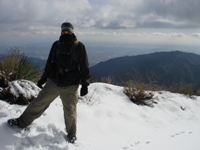"Wildnerness Strength Training and Conditioning"
-
EnFuego

- Posts: 677
- Joined: Mon Dec 15, 2008 11:14 am
I started thinking more about "conditioning" for long distance and demanding hikes. I ran across some good information. The following information is borrowed from "Hiking, Trekking & Backpacking Strength Training"
"What is involved in the training for Hiking, Trekking & Backpacking?
Traveling in the wilderness requires good cardiovascular endurance, whether you intend to do short day hikes or multi-day high-altitude trekking, scrambling, climbing, or overnight backpacking trips. Walking over varied terrain while carrying a pack is an efficient and effective way to train for such adventures. If you do not have access to hills or mountains, use whatever varied terrain is available to you, such as stairwells, short hills, stadium steps, deserted parking ramps, and sandy dunes. Use of machines such as inclined treadmills, stair climbers, or elliptical cross trainers can also be beneficial."
"Train the quadriceps for descents; the hips for supporting pack weight over variable terrain; the shoulders, upper back, and trapezius for pack carrying, gear hoisting, and using trekking poles; and the lower back, obliques, and abdominals for transferring power from the legs into forward propulsion. While hikers, trekkers, and backpackers encounter less extreme terrain than scramblers, mountaineers, or climbers do, you will still need to be able to navigate short stretches across boulder, talus, or scree fields, cross streams, traverse heather slopes, or negotiate around tree roots, all of which challenge footing and balance and may require awkward or high steps."
"The exercises suggested below point you in the proper direction for sport-specific training for pack-loaded travel. Unilateral (single-limb) lower body exercises such as those listed below are ideal for early season training in order to increase balance and joint integrity throughout the lower body musculature. Bilateral multi-joint core exercises are ideal for middle months where your focus is on building as much strength as possible."
Unilateral Lower Body Exercises
Hip Hikes for the Gluteus Medius http://www.bodyresults.com/e2Gluteusmedius.asp
1-Leg Deadlifts for Balance http://www.bodyresults.com/s2calves.asp
1-leg Hover Step Ups for Quadriceps http://www.bodyresults.com/e2balanceexercises.asp
Step Downs for Quadriceps http://www.bodyresults.com/e2Kneetest.asp
1-leg Calf Raise for Gastrocnemius and Balance http://www.bodyresults.com/e2uneventerrain.asp
Forward Straight Leg Raise for Gluteus Medius http://www.bodyresults.com/e2gluteusMedius.asp
1-Leg Squat for Balance, Gluteus Maximus and Quadriceps http://www.bodyresults.com/e21-legsquat.asp
Lunge Variations for advanced exercises to challenge Balance, Gluteus Maximus and Quadriceps http://www.bodyresults.com/e2lunge-variations.asp
Bilateral Lower Body & Core Exercises
Stiff-Leg Deadlifts for Hamstrings http://www.bodyresults.com/e2freelegs.asp
Snow Shoveler or Rotational Movements http://www.bodyresults.com/e2dirtdigger.asp
Plank Variations http://www.bodyresults.com/e2planks.asp
Oblique Twists for Rotational Movements http://www.bodyresults.com/e2Alpinecore.asp
Reverse Corner Pushouts for Rhomboids http://www.bodyresults.com/e2cornerpushups.asp
Back Extensions for Core Development to Help Support a Pack http://www.bodyresults.com/e2UpperStrengthRock.asp
Seated Cable Rows to Face for Upper Back Strength Endurance http://www.bodyresults.com/e2UpperStrengthRock.asp
Backwards Walking: Rehabilitation for the Quadriceps http://www.bodyresults.com/e2BackwardsWalking.asp
Outside Fitness Pack Routine includes a number of strength exercises you can do with a weighted pack, no gym required. http://www.bodyresults.com/e2outsidestrength.asp
"What is involved in the training for Hiking, Trekking & Backpacking?
Traveling in the wilderness requires good cardiovascular endurance, whether you intend to do short day hikes or multi-day high-altitude trekking, scrambling, climbing, or overnight backpacking trips. Walking over varied terrain while carrying a pack is an efficient and effective way to train for such adventures. If you do not have access to hills or mountains, use whatever varied terrain is available to you, such as stairwells, short hills, stadium steps, deserted parking ramps, and sandy dunes. Use of machines such as inclined treadmills, stair climbers, or elliptical cross trainers can also be beneficial."
"Train the quadriceps for descents; the hips for supporting pack weight over variable terrain; the shoulders, upper back, and trapezius for pack carrying, gear hoisting, and using trekking poles; and the lower back, obliques, and abdominals for transferring power from the legs into forward propulsion. While hikers, trekkers, and backpackers encounter less extreme terrain than scramblers, mountaineers, or climbers do, you will still need to be able to navigate short stretches across boulder, talus, or scree fields, cross streams, traverse heather slopes, or negotiate around tree roots, all of which challenge footing and balance and may require awkward or high steps."
"The exercises suggested below point you in the proper direction for sport-specific training for pack-loaded travel. Unilateral (single-limb) lower body exercises such as those listed below are ideal for early season training in order to increase balance and joint integrity throughout the lower body musculature. Bilateral multi-joint core exercises are ideal for middle months where your focus is on building as much strength as possible."
Unilateral Lower Body Exercises
Hip Hikes for the Gluteus Medius http://www.bodyresults.com/e2Gluteusmedius.asp
1-Leg Deadlifts for Balance http://www.bodyresults.com/s2calves.asp
1-leg Hover Step Ups for Quadriceps http://www.bodyresults.com/e2balanceexercises.asp
Step Downs for Quadriceps http://www.bodyresults.com/e2Kneetest.asp
1-leg Calf Raise for Gastrocnemius and Balance http://www.bodyresults.com/e2uneventerrain.asp
Forward Straight Leg Raise for Gluteus Medius http://www.bodyresults.com/e2gluteusMedius.asp
1-Leg Squat for Balance, Gluteus Maximus and Quadriceps http://www.bodyresults.com/e21-legsquat.asp
Lunge Variations for advanced exercises to challenge Balance, Gluteus Maximus and Quadriceps http://www.bodyresults.com/e2lunge-variations.asp
Bilateral Lower Body & Core Exercises
Stiff-Leg Deadlifts for Hamstrings http://www.bodyresults.com/e2freelegs.asp
Snow Shoveler or Rotational Movements http://www.bodyresults.com/e2dirtdigger.asp
Plank Variations http://www.bodyresults.com/e2planks.asp
Oblique Twists for Rotational Movements http://www.bodyresults.com/e2Alpinecore.asp
Reverse Corner Pushouts for Rhomboids http://www.bodyresults.com/e2cornerpushups.asp
Back Extensions for Core Development to Help Support a Pack http://www.bodyresults.com/e2UpperStrengthRock.asp
Seated Cable Rows to Face for Upper Back Strength Endurance http://www.bodyresults.com/e2UpperStrengthRock.asp
Backwards Walking: Rehabilitation for the Quadriceps http://www.bodyresults.com/e2BackwardsWalking.asp
Outside Fitness Pack Routine includes a number of strength exercises you can do with a weighted pack, no gym required. http://www.bodyresults.com/e2outsidestrength.asp
-
Ze Hiker

- Posts: 1432
- Joined: Mon Jul 28, 2008 7:14 pm
For nutrition, the general trend to follow is, the harder and longer you are hiking, the more simple carbs you need to be eating. This goes for any endurance activity.
The higher the intensity, the larger % you are burning energy from your muscle glycogen stores. When these run out, you will hit the "wall" as well known in marathon runs for example. You simply have to slow down when burning energy from fat.
So the key is to stop those glycogen reserves from running out. How do we do this? Carbs. Simple carbs. Sugar. Bread. These substances (foods with high Glycemic Index ratings) are the best for the same reason they are looked down upon when eating while sedentary: They will be absorbed into the blood stream very quickly.
Carbs with fiber take longer to breakdown (and may cause stomach issues), and fat and protein have to go through other chemical reactions before getting into form for usable energy.
Obviously, I'm talking about extreme case here. But since this thread was based on the idea of a "death march", trying such a hike would certainly need to follow this mantra. I think that's where AlanK's classic "thank god for GU" came from while doing some very strenuous hike. GU is all simple sugar. Cyclists, marathoners, etc... consume this sort of thing during races. Not fat and protein, or even carbs with a lot of fiber.
When I learned how to apply this, I was able to work out very intensely 4 days a week, with my hikes considered a "moderate" workout. 2 rest days, and I don't fatigue, because I make sure I recover properly by eating carbs after working out.
That said, I don't really do this on hikes. I mix a sandwich, jerky, cliff bar, trail mix, etc... (things I like!). I can go 6000 ft without eating and not be affected.
But when I did cactus to clouds (~11000 ft gain), I ate a decent amount during the hike, but not a lot of carbs, and I started 'hitting the wall' the last 1000 ft. In that case, it's good to have the knowledge that to be successful with those extreme hikes, carry a few French baguettes with you!
The higher the intensity, the larger % you are burning energy from your muscle glycogen stores. When these run out, you will hit the "wall" as well known in marathon runs for example. You simply have to slow down when burning energy from fat.
So the key is to stop those glycogen reserves from running out. How do we do this? Carbs. Simple carbs. Sugar. Bread. These substances (foods with high Glycemic Index ratings) are the best for the same reason they are looked down upon when eating while sedentary: They will be absorbed into the blood stream very quickly.
Carbs with fiber take longer to breakdown (and may cause stomach issues), and fat and protein have to go through other chemical reactions before getting into form for usable energy.
Obviously, I'm talking about extreme case here. But since this thread was based on the idea of a "death march", trying such a hike would certainly need to follow this mantra. I think that's where AlanK's classic "thank god for GU" came from while doing some very strenuous hike. GU is all simple sugar. Cyclists, marathoners, etc... consume this sort of thing during races. Not fat and protein, or even carbs with a lot of fiber.
When I learned how to apply this, I was able to work out very intensely 4 days a week, with my hikes considered a "moderate" workout. 2 rest days, and I don't fatigue, because I make sure I recover properly by eating carbs after working out.
That said, I don't really do this on hikes. I mix a sandwich, jerky, cliff bar, trail mix, etc... (things I like!). I can go 6000 ft without eating and not be affected.
But when I did cactus to clouds (~11000 ft gain), I ate a decent amount during the hike, but not a lot of carbs, and I started 'hitting the wall' the last 1000 ft. In that case, it's good to have the knowledge that to be successful with those extreme hikes, carry a few French baguettes with you!
-
AlanK

- Posts: 1069
- Joined: Thu Sep 27, 2007 9:28 pm
Zé is dead-on with his nutrition comments. I particularly agree with his observation that one need not worry a lot about eating on a modest hike. The 6000' of elevation gain he mentions fits with the Bear Flat to Baldy hike. I would eat nothing on such a hike unless it overlapped lunch time, in which case a typical packed lunch would be fine. For something like Cactus to Clouds, on the other hand, I definitely pay attention to eating carbs (GU being one example) on the hike.
One thing I would add is that electrolyte replacement matters on longer hikes, but this becomes important on shorter ones in hot weather, when one is taking in a lot of fluid and promptly sweating it out.
One situation that makes life more complicated is multi-day hikes. My son and I did the John Muir Trail a couple of years back. Carrying the food on ones back forces one to adjust ones diet. Fat is dense in calories but is not a "high octane" fuel. I found it impossible to travel light enough to allow covering 25 miles per day while carrying enough carbohydrate-rich foods to support high-intensity exercise. Some compromise is necessary and it is almost certain that one ends up running a caloric deficit. Figuring out the right trade-offs was part of the fun.
One thing I would add is that electrolyte replacement matters on longer hikes, but this becomes important on shorter ones in hot weather, when one is taking in a lot of fluid and promptly sweating it out.
One situation that makes life more complicated is multi-day hikes. My son and I did the John Muir Trail a couple of years back. Carrying the food on ones back forces one to adjust ones diet. Fat is dense in calories but is not a "high octane" fuel. I found it impossible to travel light enough to allow covering 25 miles per day while carrying enough carbohydrate-rich foods to support high-intensity exercise. Some compromise is necessary and it is almost certain that one ends up running a caloric deficit. Figuring out the right trade-offs was part of the fun.
-
cougarmagic

- Posts: 1411
- Joined: Wed May 07, 2008 5:21 pm
I've been making extra effort to eat fat & protein on longer hikes, because of all the talk about spikes in blood sugar, and making better use of energy that is slower and steadier. I have a huge sweet tooth, and I could eat candy all day long - I assume the idea with high octane carbs would be to make sure it's a steady supply, that if you have a bag of skittles at lunch and then nothing else, you're going to bonk pretty quickly. Is that right?
-
AlanK

- Posts: 1069
- Joined: Thu Sep 27, 2007 9:28 pm
I won't speak for anyone else, but I have never noticed much effect from eating a candy bar or the like. So, I don't think much about blood sugar spikes. If I am hiking "only" 15 miles or so, even with considerable uphill, I know that my body has all of the stored glycogen (carbohydrate fuel) it needs. The only reason to eat anything is because one feels hungry (as in my earlier mention of lunch time). What I eat is whatever I feel like carrying.
-
Ze Hiker

- Posts: 1432
- Joined: Mon Jul 28, 2008 7:14 pm
That "talk about spikes in blood sugar" is relevant really during a sedentary state. Diabetics are especially sensitive because of insulin resistance.cougarmagic wrote:I've been making extra effort to eat fat & protein on longer hikes, because of all the talk about spikes in blood sugar, and making better use of energy that is slower and steadier. I have a huge sweet tooth, and I could eat candy all day long - I assume the idea with high octane carbs would be to make sure it's a steady supply, that if you have a bag of skittles at lunch and then nothing else, you're going to bonk pretty quickly. Is that right?
However, when people are exercising, they are actually in a state of higher sensitivity. They can actually absorb more carbohydrates. So I don't think you will bonk. Of course if you eat 600 calories of sugar after doing only 1000 ft of gain, then you might. Of course, steady intake is better, but still simple carbs in a steady fashion probably works the best.
You always want a little bit of protein, but having protein would be a bit more important post hike for recovery purposes.
-
Taco

- Snownado survivor
- Posts: 6153
- Joined: Thu Sep 27, 2007 4:35 pm
I like that road. Goes to the top of Pine Mountain 4,539.
-
Kit Fox

- Posts: 152
- Joined: Tue Dec 25, 2007 11:33 am
Speaking of Wilderness Training, the company called http://www.wildernessathlete.com/images/wa_catalog.pdf
www.wildernessathlete.com has a 70% sale on all of their items.
Manually type in WA70%OFF in the coupon section.
I've always wanted to try their stuff, but could never afford it until now.
www.wildernessathlete.com has a 70% sale on all of their items.
Manually type in WA70%OFF in the coupon section.
I've always wanted to try their stuff, but could never afford it until now.
-
EnFuego

- Posts: 677
- Joined: Mon Dec 15, 2008 11:14 am
Kit Fox - Thanks for the "sale" info. I'm going now to order some stuff.
-
Ze Hiker

- Posts: 1432
- Joined: Mon Jul 28, 2008 7:14 pm
A small take on what to eat for breakfast
Basically, if you wait till the morning of to get food in for energy, you'll be screwed. Aside from that, eat some high GI carbs and lots of water.
Basically, if you wait till the morning of to get food in for energy, you'll be screwed. Aside from that, eat some high GI carbs and lots of water.
-
edenooch

- Posts: 504
- Joined: Fri Jul 03, 2009 7:42 pm
Kit Fox thanks for that link. i might order a bunch of those day packs
I usually Carbo load and drink 4 liters of h2o the day before. On the hike i take electrolye water and Just enough food to replace calories lost and sustained energy (cliff bars and sandwich with thick bread) . I used to bring a nice big meal to eat for lunch but always felt like to much
I usually Carbo load and drink 4 liters of h2o the day before. On the hike i take electrolye water and Just enough food to replace calories lost and sustained energy (cliff bars and sandwich with thick bread) . I used to bring a nice big meal to eat for lunch but always felt like to much
-
Sam Page

- Posts: 267
- Joined: Fri Sep 04, 2009 10:59 am
Mick Fowler (the famous British alpinist) said something like the following: "Mountain climbing is not something I get in shape for. Mountain climbing is something I do to get in shape."
-
Taco

- Snownado survivor
- Posts: 6153
- Joined: Thu Sep 27, 2007 4:35 pm
Good way to put it.
Fowler is the man, BTW.
Fowler is the man, BTW.
-
seadweller
- Posts: 48
- Joined: Thu Feb 28, 2008 9:28 am
Just put on a pack and get out there. Don't get caught in all the protein/carbo/fat nonsense. One simple rule to follow is that the body becomes good at doing what it is told to do, over and over again --- Whether you like it or not, you will become good at doing what you do most often.
If you look at the poor countries like in South America and Asia, where guiding ia a big thing, those guides do not have stairmaster --- they don't know how to spell protein or know what carbs are. But these poor people repeatedly accompany climbers for their livelihood and as a result, they can kick the best of the best western A$$es ----
In the west, we complicate stuff wayway too much -- too much science is involved ----
The secret to becoming a great climber is simple: Go out there and climb climb climb ----
thaankyou,
If you look at the poor countries like in South America and Asia, where guiding ia a big thing, those guides do not have stairmaster --- they don't know how to spell protein or know what carbs are. But these poor people repeatedly accompany climbers for their livelihood and as a result, they can kick the best of the best western A$$es ----
In the west, we complicate stuff wayway too much -- too much science is involved ----
The secret to becoming a great climber is simple: Go out there and climb climb climb ----
thaankyou,
-
Ze Hiker

- Posts: 1432
- Joined: Mon Jul 28, 2008 7:14 pm
except they do that for a living. we sit on our assess during the week.seadweller wrote: Just put on a pack and get out there. Don't get caught in all the protein/carbo/fat nonsense. One simple rule to follow is that the body becomes good at doing what it is told to do, over and over again --- Whether you like it or not, you will become good at doing what you do most often.
If you look at the poor countries like in South America and Asia, where guiding ia a big thing, those guides do not have stairmaster --- they don't know how to spell protein or know what carbs are. But these poor people repeatedly accompany climbers for their livelihood and as a result, they can kick the best of the best western A$$es ----
In the west, we complicate stuff wayway too much -- too much science is involved ----
The secret to becoming a great climber is simple: Go out there and climb climb climb ----
thaankyou,
-
everyday

- Posts: 455
- Joined: Tue Mar 15, 2011 12:36 pm
Speak for yourself dood. Im a housekeeper. Im runnin around all day, carrying sheets n towels (Huge 10-25lb stacks of em) up n down stairs at the hotel all day, and clean 10-14 rooms a day. I NEVER get to sit down, we dont even get a lunch-break. Then, after 6-8 hrs of that, I walk home, change into my runnin clothes, and run at least 6 miles, 4 days a week out on the trails. All at 7000ft elevation. And 2X a month i run to the bottom of the grand canyon and back up. If all ya do is sit on yer butt all week, thats your choice.
@ Seadweller--exactly! ...well, for me its running, but same idea applies the only thing guaranteed to make you better at something is simply doing it more. Ive learned that from experience, theres no magic bullet or carb or exercise thatll make you consistently great. Only putting in the time and effort will. It seems so many people are always looking for a shortcut to fitness instead of seeing it as simply a way to live everyday.
@ Seadweller--exactly! ...well, for me its running, but same idea applies the only thing guaranteed to make you better at something is simply doing it more. Ive learned that from experience, theres no magic bullet or carb or exercise thatll make you consistently great. Only putting in the time and effort will. It seems so many people are always looking for a shortcut to fitness instead of seeing it as simply a way to live everyday.
-
Taco

- Snownado survivor
- Posts: 6153
- Joined: Thu Sep 27, 2007 4:35 pm
Come back here and be a bum with me. Then it too will be what you do for a living.Zé wrote:except they do that for a living. we sit on our assess during the week.seadweller wrote: Just put on a pack and get out there. Don't get caught in all the protein/carbo/fat nonsense. One simple rule to follow is that the body becomes good at doing what it is told to do, over and over again --- Whether you like it or not, you will become good at doing what you do most often.
If you look at the poor countries like in South America and Asia, where guiding ia a big thing, those guides do not have stairmaster --- they don't know how to spell protein or know what carbs are. But these poor people repeatedly accompany climbers for their livelihood and as a result, they can kick the best of the best western A$$es ----
In the west, we complicate stuff wayway too much -- too much science is involved ----
The secret to becoming a great climber is simple: Go out there and climb climb climb ----
thaankyou,
-
Ze Hiker

- Posts: 1432
- Joined: Mon Jul 28, 2008 7:14 pm
wow, you run a little bit, congrats.everyday wrote: Speak for yourself dood. Im a housekeeper. Im runnin around all day, carrying sheets n towels (Huge 10-25lb stacks of em) up n down stairs at the hotel all day, and clean 10-14 rooms a day. I NEVER get to sit down, we dont even get a lunch-break. Then, after 6-8 hrs of that, I walk home, change into my runnin clothes, and run at least 6 miles, 4 days a week out on the trails. All at 7000ft elevation. And 2X a month i run to the bottom of the grand canyon and back up. If all ya do is sit on yer butt all week, thats your choice.
@ Seadweller--exactly! ...well, for me its running, but same idea applies the only thing guaranteed to make you better at something is simply doing it more. Ive learned that from experience, theres no magic bullet or carb or exercise thatll make you consistently great. Only putting in the time and effort will. It seems so many people are always looking for a shortcut to fitness instead of seeing it as simply a way to live everyday.
you missed my point. Many / most people have desk jobs. Given that constraint, they can't spend hours upon hours each day hiking like Himalayan porters do. If they want any level of conditioning even close to those porters, they're going to have to do it in a more systematic way. Or find another job.
I could make someone have a higher level of endurance conditioning than most people with 20-30 minutes of proper training several days a week. Is that better conditioning than essentially exercising all day long like a porter? No. But it's probably better than yours. And fits into most people's socioeconomical "constraints".
-
Taco

- Snownado survivor
- Posts: 6153
- Joined: Thu Sep 27, 2007 4:35 pm
Pfff, I've met this Ze character. He's a big USC fan and I hear he's got a big gut. 
-
AW~

- Posts: 2096
- Joined: Mon Oct 01, 2007 12:00 pm
http://www.trailsherpa.com/how-to-hike/
*Not paid for or associated with the AW PAC 8)Do you know how to hike like a badass?
Most people would say they do. But becoming a badass day hiker requires more than just putting one foot in front of the other.
Badass day hikers can log double digit miles in a single day. They carry light packs containing only what they need yet they’re prepared for the worst case scenario. They know exactly where they are going, how to get there and back safely, and they will likely use a few special skills while they’re doing it.
Badass day hikers can test their limits in a single day, see more of the trail than the average hiker, and look good doing it....
